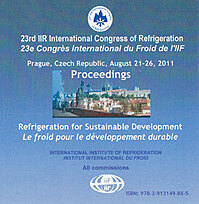
IIR document
A comparison between lithium bromide-water and ionic liquid-water as working solution for absorption refrigeration cycles.
Number: pap. ID: 287
Author(s) : RÖMICH C., MERKEL N., SCHABER K., et al.
Summary
Reliable vapour-liquid-equilibria (VLE) measurements are required for the estimation of the performance of an absorption chiller. Thus the water partial pressure of a mixture of water and a room temperature ionic liquid (RTIL) was measured in two different ways: Via Fourier-transform-infrared (FT-IR) Spectroscopy in a dynamic cell and via Raman-spectroscopy in a static cell. Additional mixture properties as viscosity and specific heat capacity were measured as a function of concentration. An absorption chiller designed for LiBr-water with a nominal cooling capacity of 10 kW was operated with a mixture of diethylmethylammonium methanesulfonate (DEMA MeSO3) and water in order to demonstrate the performance of new working solutions with RTILs. Although the measured coefficient of performance (COP) is comparable to the one of lithium bromide (LiBr)-water, the higher viscosities of working solutions with RTILs cause an insufficient heat and mass transfer which leads to a low refrigeration output.
Available documents
Format PDF
Pages: 8 p.
Available
Public price
20 €
Member price*
Free
* Best rate depending on membership category (see the detailed benefits of individual and corporate memberships).
Details
- Original title: A comparison between lithium bromide-water and ionic liquid-water as working solution for absorption refrigeration cycles.
- Record ID : 30002421
- Languages: English
- Source: Proceedings of the 23rd IIR International Congress of Refrigeration: Prague, Czech Republic, August 21-26, 2011. Overarching theme: Refrigeration for Sustainable Development.
- Publication date: 2011/08/21
Links
See other articles from the proceedings (569)
See the conference proceedings
-
Second law analysis of multi-stage lithium brom...
- Author(s) : LEE S. F., SHERIF S. A.
- Date : 2000
- Languages : English
- Source: ASHRAE Transactions. 2000 Winter Meeting, Dallas, Texas + CD-ROM.
View record
-
A Gibbs energy equation for LiBr/H2O solutions.
- Author(s) : KIM D. S., INFANTE FERREIRA C. A.
- Date : 2004/08/01
- Languages : English
- Source: Natural Working Fluids 2004: 6th IIR-Gustav Lorentzen Conference
- Formats : PDF
View record
-
Energy and exergy analysis of H2O/Li...
- Author(s) : PRIETO J., AYOU D. S., CORONAS A.
- Date : 2022/04
- Languages : English
- Source: XI Congreso Ibérico y IX Congreso Iberoamericano de Ciencias y Técnicas del Frío, CYTEF 2022.
- Formats : PDF
View record
-
Second law analysis of a lithium bromide/water ...
- Author(s) : LEE S. F., SHERIF S. A.
- Date : 1999/09/19
- Languages : English
- Source: 20th International Congress of Refrigeration: Refrigeration into the Third Millennium.
- Formats : PDF
View record
-
Statistical study of experimental results for a...
- Author(s) : GUTIERREZ G., SANCHEZ I., RODRIGUES P., et al.
- Date : 2010/04/12
- Languages : English
- Source: 9th IIR-Gustav Lorentzen Conference on Natural Working Fluids (GL2010). Proceedings. Sydney, Australia, April 12-14, 2010.
- Formats : PDF
View record
